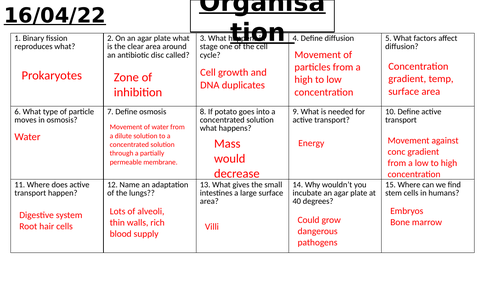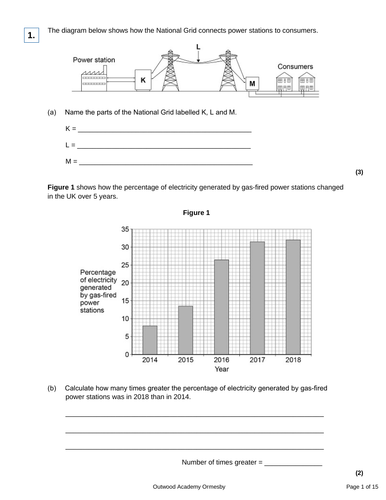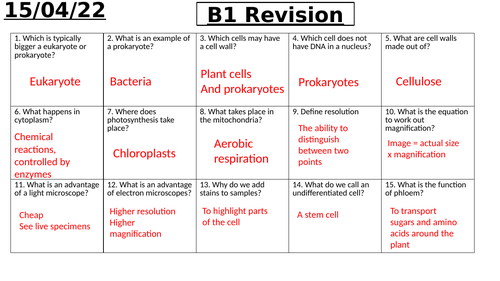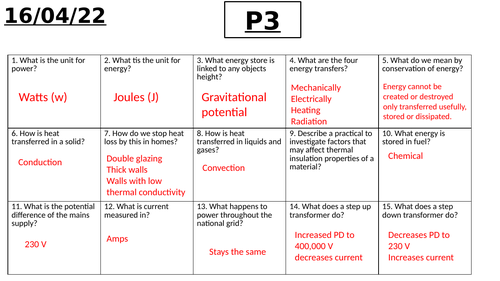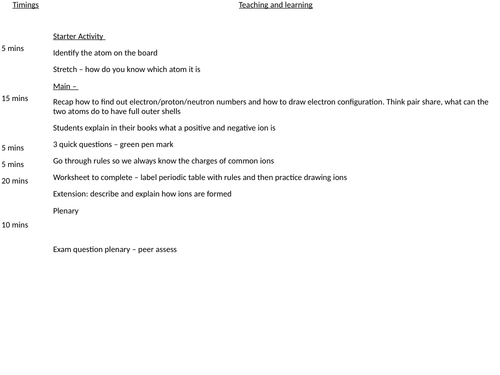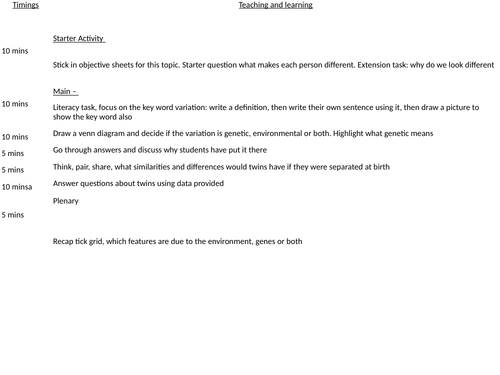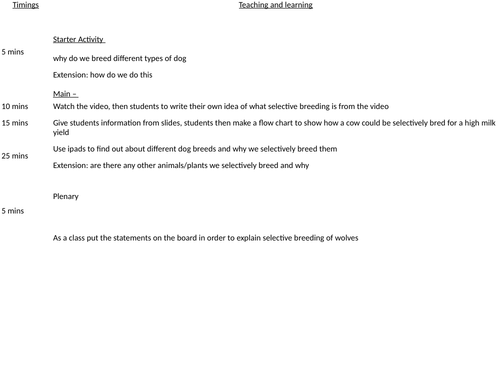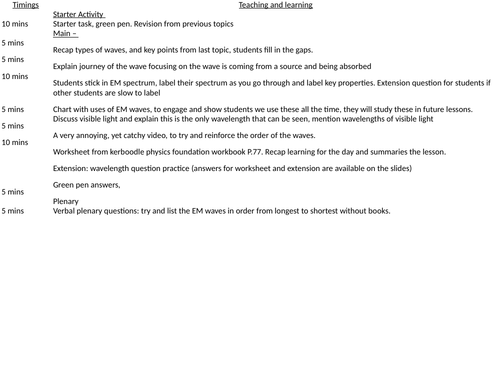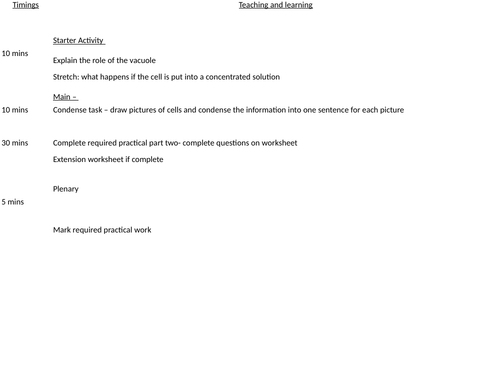
123Uploads
29k+Views
8k+Downloads
All resources

B2.1 Cell division
Aimed at a mixed ability year 9 class
Starter: match up the key words to the defintions
Main: discuss key words and then think pair share, how do we go from a single cell to an embryo to who we are today
Research mitosis, move around the room and find out about the steps
Complete literacy question task to reinforce learning for the day
Plenary: go through answers to the worksheet and tweet the most important thing they have learnt today

P2 Physics revision 2022
P2 revision based around the pre released content
used as an hour tutoring session

C3.3 Ionic bonding - foundation
Aimed at a lower ability class
Starter Activity
Ions recap, what charge do elements have in different groups
Stretch question to think about how group 1 and 2 will interact with group 6 and 7
Main –
Go through the video and answer the questions, go through answers
Practice drawing ionic compounds Extension: explain the difference between KBr and K2O
Go through the answers which are on the slides
Exam question practice to move onto if have a chance
Plenary
4 mark exam question – peer assess
Good to show the detail they need in their answers

C3.2 atoms into ions - Foundation
aimed at a lower ability class
Starter Activity
Identify the atom on the board
Stretch – how do you know which atom it is
Main –
Recap how to find out electron/proton/neutron numbers and how to draw electron configuration. Think pair share, what can the two atoms do to have full outer shells
Students explain in their books what a positive and negative ion is
3 quick questions – green pen mark
Go through rules so we always know the charges of common ions
Worksheet to complete – label periodic table with rules and then practice drawing ions
Extension: describe and explain how ions are formed
Plenary
Exam question plenary – peer assess

C3.5 covalent bonding - foundation
aimed at a lower ability class
Starter Activity
Mark homework
Main –
Think pair share – spot the difference between ionic and covalent bonding. Then write down definition of covalent bonding
Watch video, only watch until 2 minutes. Answer questions whilst video is going. Goo through and green pen answers after
Go through the two examples on the board and show what happens
Students then have a go at completing their worksheet to show covalent bonds
Extension: decide if the compounds are ionic or covalent and explain how they know
Plenary
Plenary, fill in the gaps and go over answers

C3.4 Giant ionic structures - foundation
aimed at a lower ability class
Starter Activity
Using previous knowledge make predictions about ionic compounds
Main –
Go through and discuss giant ionic lattices
Students move around the room to find the information sheet to find out if there prediction was correct or not and why
Practical with a dissolved ionic compound to show it can conduct electricity. Make sure say that molten ionic compounds too and what a molten ionic compound is
Plenary
Exam question plenary

B13.1 variation and evolution
Aimed at a low ability class.
Starter Activity
Stick in objective sheets for this topic. Starter question what makes each person different. Extension task: why do we look different
Main –
Literacy task, focus on the key word variation: write a definition, then write their own sentence using it, then draw a picture to show the key word also
Draw a venn diagram and decide if the variation is genetic, environmental or both. Highlight what genetic means
Go through answers and discuss why students have put it there
Think, pair, share, what similarities and differences would twins have if they were separated at birth
Answer questions about twins using data provided
Plenary
Recap tick grid, which features are due to the environment, genes or both

B13.3 selective breeding
Aimed at a low ability class
Starter Activity
why do we breed different types of dog
Extension: how do we do this
Main –
Watch the video, then students to write their own idea of what selective breeding is from the video
Give students information from slides, students then make a flow chart to show how a cow could be selectively bred for a high milk yield
Use ipads to find out about different dog breeds and why we selectively breed them
Extension: are there any other animals/plants we selectively breed and why
Plenary
As a class put the statements on the board in order to explain selective breeding of wolves

C12. treating waste water
For low ability students. targets level 4
Starter: differentiated stater based on prior learning of the topic
answers on following slide
Main: think pair share: where do we get waste water from
video: watch a video, try and pick out what the stages of treatment for waste water are
differentiated worksheets, to explain the process of waste water treatment
Extension: differentiated extension questions
Plenary: copy and complete two sentences
Bundle

C11 - The earths atmosphere
All resources aimed at foundation students
C11.1 + C11.2 combined into one lesson
C11.3 greenhouse gases
C11.4 global climate change
C11.5 atmospheric pollutants

P12.1 Electromagnetic spectrum
Aimed at low ability students. Targets of level 4.
Starter task, green pen. Revision from previous topics
Main –
Recap types of waves, and key points from last topic, students fill in the gaps.
Explain journey of the wave focusing on the wave is coming from a source and being absorbed
Students stick in EM spectrum, label their spectrum as you go through and label key properties. Extension question for students if other students are slow to label
Chart with uses of EM waves, to engage and show students we use these all the time, they will study these in future lessons. Discuss visible light and explain this is the only wavelength that can be seen, mention wavelengths of visible light
A very annoying, yet catchy video, to try and reinforce the order of the waves.
Worksheet from kerboodle physics foundation workbook P.77. Recap learning for the day and summaries the lesson.
Extension: wavelength question practice (answers for worksheet and extension are available on the slides)
Green pen answers,
Plenary
Verbal plenary questions: try and list the EM waves in order from longest to shortest without books.

B13.2 Evolution by natural selection
Aimed at a low ability class
Starter Activity
Pictures of animals with the albinism mutation, students decide if they think this is beneficial or not and explain their answer
Main –
Think pair share for one minute to discuss the word mutation. Then do a vocab lab for the definition
Fill in the blanks about mutations, print for LA students
Watch video about Charles darwins natural selection. Then cut and stick the statements into order to describe natural selection. Green pen mark
Explain how the lion is adapted and how these adaptations are beneficial.
Complete exam questions. Extension question available on powerpoint.
Plenary
Mark exam question

B1.1 The world of the microscope
Starter Activity
Starter questions about the microscope
Main –
Students stick microscopes in the middle of their page. Use the information on the slide to label the parts of the microscope. Extension: to explain how to use a microscope
Check answers – answers on the PowerPoint. Students check answers, ensure students know the function of each part of the microscope.
Explain magnification and resolution, get students to write the definitions.
Think pair share, pictures of light and electron microscopes, see what students can summarise as differences
Students to make a grid in their books light vs electron microscopes, make notes on any differences from the video
Sort the statements and go through answers
Explain how to work out total magnification and then practice.
Explain the magnification equation and then practice using it
Plenary
Fill in the gaps in the sentences

Osmosis required practical
Two lessons split for the required practical, differentiated sheets available and practical worksheet

C3 Quantitative chemistry tutoring
A tutoring powerpoint I used does not include percentage yield.
Comes with a key question document and exam questions.
All answers to powerpoint included as animations or in the notes below
Bundle

Separation techniques KS3
Bundle of lessons for year 8
L1 - elements compounds mixtures
L2 - Dissolving
L3 - Solubility
L4 & 5 - filtering and evaporating
L6 - Melting points
L7 - Simple distillation
L8 - Fractional distillation
L9 - Chromatography

Biology paper 1 revision
complete paper one revision.
Aimed at low ability foundation students.
Inspired by Dr Edmunds
Booklets include fact sheets for each topic, each fact sheet has page numbers from the CGP foundation revision guide for support.
There are answers for these fact sheets for students to check their answers.
Each topic also has a page of exam questions for students to practice their knowledge. answers for these are in the back of the booklets
Hopefully will be of help.
Any feedback welcome :)


